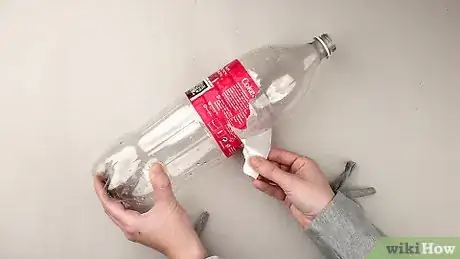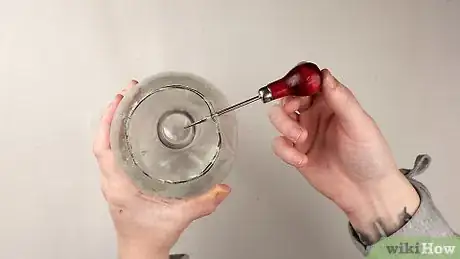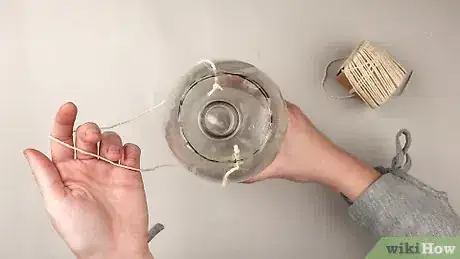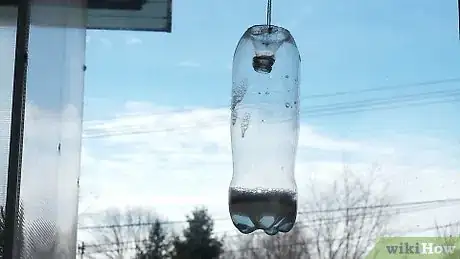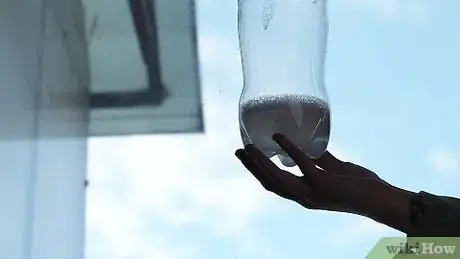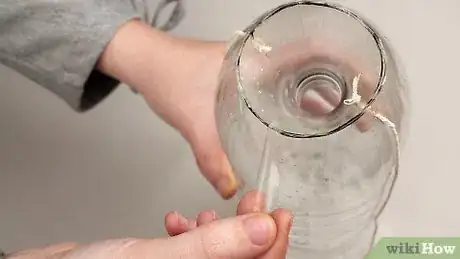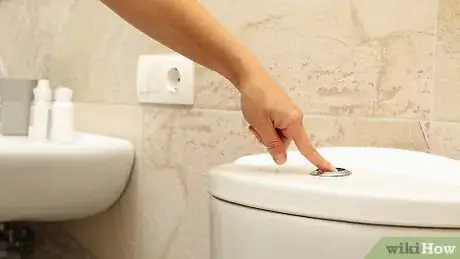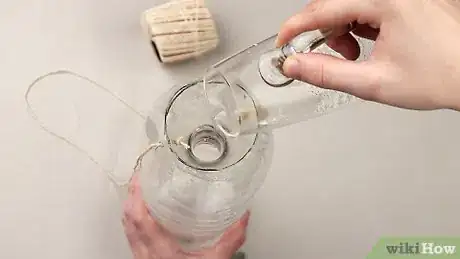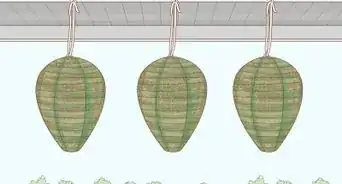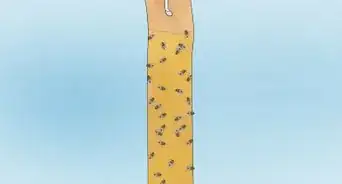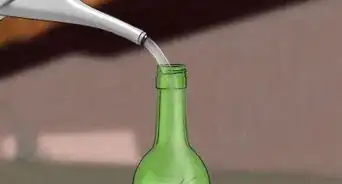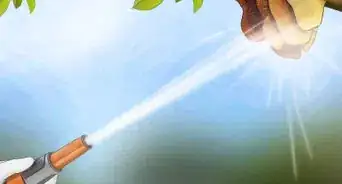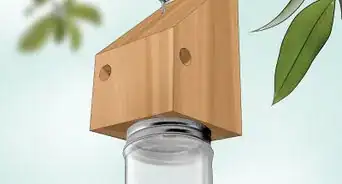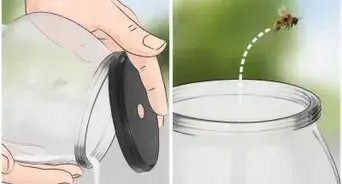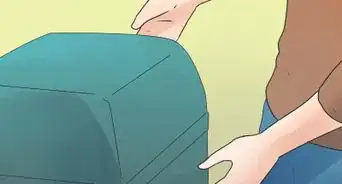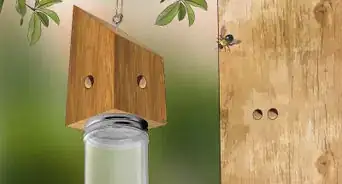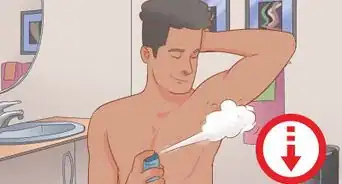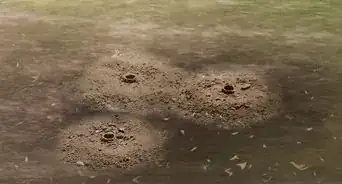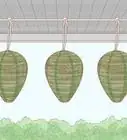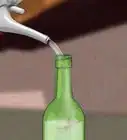This article was co-authored by Chris Parker. Chris Parker is the Founder of Parker Eco Pest Control, a sustainable pest control service in Seattle, Washington. With over seven years of experience, Chris specializes in Integrated Pest Management and doesn’t use any chemicals for pest removal. He offers removal services for ants, rodents, fleas, spiders, wasps, and more. Chris is a certified Commercial Pesticide Applicator in Washington State and received his bachelor’s from the University of Washington.
wikiHow marks an article as reader-approved once it receives enough positive feedback. This article received 24 testimonials and 100% of readers who voted found it helpful, earning it our reader-approved status.
This article has been viewed 2,397,016 times.
When wasps make a nest too close to home, they can pose a danger to people and household pets. While you can purchase wasp traps, they are often sticky and difficult to set up. Instead, try making your own reusable wasp trap out a plastic bottle, and some enticing bait like meat, sugar, or dish soap. This homemade wasp trap will not only be effective in catching the wasps, but it will also be easy for you to set up and maintain.
Steps
Making the Wasp Trap
-
1Remove the labels from a plastic 2 L (0.53 US gal) soda bottle. You want to be able to easily see through the bottle; otherwise, you won't know whether you caught any wasps or not. If the bottle you selected has labels that cannot be removed, you can use that bottle, but know that it will be harder to check on.[1]
- You don't have to use a 2 L (0.53 US gal) plastic bottle to create this wasp trap. You can use a different type of plastic bottle or carton to make this trap, but make sure that the opening of the bottle or carton is large enough for the wasp to crawl through.[2]
-
2Draw a line with a marker around the neck of the plastic bottle. The line should be just under the neck of the bottle and where the mid-section of the bottle becomes a straight cylinder. The line does not have to perfectly straight as it is just to help guide you when cutting the bottle.[3]
- For a carton, draw the line around the top portion of the carton, just under the natural crease that forms the triangular top.
Advertisement -
3Cut the neck off the plastic bottle along the marked line. You can use a razor knife, a pair of scissors, or whatever you are most comfortable using. The implement just needs to be sharp enough to cut through the bottle.[4]
- When you make your first cut, the plastic bottle can be slippery, so take your time and be careful not to cut yourself. To reduce slippage, place the bottle on a slightly damp cloth or towel. This will create needed traction to hold the bottle steady.
- You are going to need both the base and neck portions of the bottle to make this trap, so cut along your line.
-
4Using a paper towel, grease the inside of the bottle and funnel with olive oil. This will create an additional slippery barrier that the wasps will be unable to climb. It is not necessary to do this, as the oil can become tacky over time if you do not maintain it or clean the bottle periodically, but it can make the trap temporarily more effective. Instead of olive oil, you can also use petroleum jelly.
-
5Flip the neck upside-down, and place the neck into the bottle. The neck of the bottle will serve as a funnel for the wasps to enter, but not exit, the trap. Make sure to remove the cap before placing the neck into the bottle. This is the opening where the wasps will be entering.
-
6Tape the two pieces together along the cut edges. The tape will hold the funnel in place. It is best to use a clear packing tape to do this, so you can easily see when a wasp is inside the trap.[5]
- For tape that is not clear, like duct tape, cut the strip in half to keep the band of tape as narrow as possible.
-
7Make two holes on opposite sides of the funnel's edge. Use a hole-puncher, scissors, or another pointy implement to make the 2 holes. Just be careful when making the holes, so you do not injure yourself.[6]
-
8Tie the ends of a 12 in (30 cm) long string to each punched hole. This will create a handle so you can hang your wasp trap. You can use any type of string you have around, but try to pick one that is sturdy enough to withstand the weight of the trap, and any wind that might blow it around.[7]
- A sturdy twine or even an old shoelace would work well as a handle for the wasp trap.
Baiting and Setting up the Trap
-
1Use grease or meat scraps as bait during spring and early summer. Dilute the mixture with some water to create a solution that will aid in drowning the wasps. In the spring and early summer months, the wasps will be focusing on making nests and laying eggs, so the wasps will be out looking for protein.
- If you use meat during this time, you may even catch the queen wasp, which will force the rest of the nest to relocate.
-
2Bait the trap with something sweet during late summer and early fall. Mix the sweet substance with water and liquid dish soap. In the later summer and early fall months, the wasps want more energy, so they will be looking for something sweet. The dish soap will break the surface tension of the water and drown the wasp. Some sweet options include: sugar, lemon juice, or apple cider vinegar. You may have to experiment with the type and amount of sweet options to attract the wasps.[8]
- You can increase the amounts of water and soap as needed to fill your trap, but try and keep a ratio of 1 teaspoon (4.9 mL) of liquid dish soap for every 1 cup (240 mL)} of water.[9]
- If you do not want to drown the wasp, but instead release it, do not add dish soap to the bait solution. Using dish soap will coat any wasps that escape and eventually suffocate the wasps.[10]
-
3Pour the mixed bait solution into the funnel of the wasp trap. The bait solution should not cover the opening of the bottle as this will prevent the wasps from entering the trap. You want about 1–2 in (2.5–5.1 cm) of the solution inside of the bottle. This will force the wasps to completely enter the trap in order to access the bait.[11]
- If you are not using a 2 L (0.53 US gal) plastic bottle, and the bottle you chose instead is short, add less solution. You want at least 2 in (5.1 cm) of space between the baiting solution and the opening of the funnel inside of the shorter trap.
- If you are planning on releasing the wasps, then only add 1–3 tablespoons (15–44 mL) of the solution to the bottle. This will be enough solution to attract the wasp, but not enough to drown them.
-
4Set up your trap outside on the ground or hang it up. Stand the trap on a small table or stool so it is slightly elevated from the ground. You can also hang the trap from a fence post or a low tree branch as well. Traps that are hung about 4 feet (1.2 m) from the ground tend to catch more wasps than traps left on the ground.
- Since the trap will be attracting wasps, you don't want to place it in an area close to where you frequently hang out or work. A good distance would be about 27 feet (8.2 m) away from your main gathering area outside.[12]
Removing the Wasps and Refilling the Bait
-
1Check the wasp trap daily. You want to make sure that you are using the right bait and placing your trap in the right spot to attract the wasps. At least for the first few days or until you know the wasp trap is working, check on the wasp trap at least once a day.[13]
- If you do not seem to be catching any wasps, try relocating the trap to another area where you know you have seen the wasps, or try a different bait solution combination.
-
2Undo the tape on the trap, and clean it out every 3 days. If you leave the trap unattended, the dead wasps will float on the surface of the bait solution and create a platform for other wasps to rest on. Make sure that all of the wasps in the trap are dead before removing the tape. Any wasps that are left alive in the trap will most likely be very aggressive.[14]
- Release living wasps with extreme caution. Unlike bees, wasps are aggressive by nature. You can release the wasps if you want, but do it away from your property and not in a place where other people hang out. Wasps will alert the rest of the colony if given the chance, so do not release the wasp near the nest. If there are uninhabited woods or fields down the road from you, try releasing the wasps there.[15]
- If you are going to release any living wasps, make sure to wear gloves, and clothing that will cover your arms and legs.[16]
-
3Bury or flush the dead wasps to avoid attracting others. Wasps are notorious for attacking in groups if they sense another wasp is in danger of being harmed. The dead body of a wasp will release a chemical that will attract the rest of the wasp colony. Just simply dumping the bodies of the wasps or tossing them into a trash can will only attract more nearby wasps.[17]
-
4Tape the wasp trap together again, and refill it with your bait solution. Unlike traditional sticky wasp traps, this homemade wasp trap can be used repeatedly. You just have to make more of your bait solution, and refill it.[18]
- Also apply more of the olive oil or petroleum jelly if you used that to coat the inside of your trap.
- If the trap develops a rotting or sour smell, rinse it with hot water before filling it with more bait solution. If the smell persists, you may want to consider making another wasp trap, or using apple cider vinegar in the trap to combat the smell.
Community Q&A
-
QuestionCan I use a milk carton instead of a plastic bottle?
 Community AnswerYes, it's the same concept. As long as the hole for the opening is pointing down, most of the wasps will never figure out how to get out. Also, if you add apple juice with a bit of vinegar to it, honey bees will never go in. I am a beekeeper. The wasps and hornets like the decaying smell of vinegar and the bees do not. Wasps fly forward and you will see them bouncing off the sides.They cannot hover and go straight up where they came from. Eventually they get exhausted and fall into the liquid.
Community AnswerYes, it's the same concept. As long as the hole for the opening is pointing down, most of the wasps will never figure out how to get out. Also, if you add apple juice with a bit of vinegar to it, honey bees will never go in. I am a beekeeper. The wasps and hornets like the decaying smell of vinegar and the bees do not. Wasps fly forward and you will see them bouncing off the sides.They cannot hover and go straight up where they came from. Eventually they get exhausted and fall into the liquid. -
QuestionWould eggs do in place of meat?
 Community AnswerI would not recommend it. The smell would be really bad and would attract other animals such as skunks or raccoons to the trap.
Community AnswerI would not recommend it. The smell would be really bad and would attract other animals such as skunks or raccoons to the trap. -
QuestionWill all wasps be trapped in the bottle or will some escape, posing a threat to children playing in the fields?
 Community AnswerIt is possible for them to escape. Also the article says, "Do not place the trap anywhere near where children or pets will be spending time, as living wasps will be attracted by the trap.".
Community AnswerIt is possible for them to escape. Also the article says, "Do not place the trap anywhere near where children or pets will be spending time, as living wasps will be attracted by the trap.".
Warnings
- Do not add honey to your trap. This will attract more bees than wasps.[20]⧼thumbs_response⧽
- Do not place the trap anywhere near where children or pets will be spending time. The wasps will be attracted to the trap, so you do not want it in a popular hangout area on your property.[21]⧼thumbs_response⧽
- Be careful when handling the wasps. Even if the wasp is dead, the stinger is still active and can puncture you. If you are allergic to wasps and get stung once or multiple times, seek medical help immediately. Even if you are not allergic to wasp stings, receiving multiple stings can require medical attention.[22]⧼thumbs_response⧽
Things You'll Need
- 2 L (0.53 US gal) soda bottle
- Sharp razor blade, or scissors to cut the bottle
- Hole-puncher
- Packing tape or Duct tape
- 12 in (30 cm) long piece of string
- Water
- Liquid dish soap
- Sugar, lemon juice, vinegar, meat grease, or meat scraps
- Olive oil, or petroleum jelly (optional)
References
- ↑ https://gardenerdy.com/homemade-wasp-traps-how-to-make-your-own-wasp-trap
- ↑ http://theselfsufficientliving.com/8-homemade-wasp-traps-to-get-rid-of-wasps/
- ↑ https://www.apartmenttherapy.com/the-2-liter-soda-bottle-wasp-t-43290
- ↑ https://www.apartmenttherapy.com/the-2-liter-soda-bottle-wasp-t-43290
- ↑ https://www.bobvila.com/articles/homemade-wasp-trap/
- ↑ https://gardenerdy.com/homemade-wasp-traps-how-to-make-your-own-wasp-trap
- ↑ https://www.bobvila.com/articles/homemade-wasp-trap/
- ↑ https://www.bobvila.com/articles/homemade-wasp-trap/
- ↑ https://www.bobvila.com/articles/homemade-wasp-trap/
- ↑ https://gardenerdy.com/homemade-wasp-traps-how-to-make-your-own-wasp-trap
- ↑ https://www.bobvila.com/articles/homemade-wasp-trap/
- ↑ https://www.bobvila.com/articles/homemade-wasp-trap/
- ↑ https://gardenerdy.com/homemade-wasp-traps-how-to-make-your-own-wasp-trap
- ↑ https://gardenerdy.com/homemade-wasp-traps-how-to-make-your-own-wasp-trap
- ↑ https://www.bobvila.com/articles/homemade-wasp-trap/
- ↑ https://www.bobvila.com/articles/homemade-wasp-trap/
- ↑ https://gardenerdy.com/homemade-wasp-traps-how-to-make-your-own-wasp-trap
- ↑ https://www.bobvila.com/articles/homemade-wasp-trap/
- ↑ https://gardenerdy.com/homemade-wasp-traps-how-to-make-your-own-wasp-trap
- ↑ https://www.bobvila.com/articles/homemade-wasp-trap/
- ↑ https://gardenerdy.com/homemade-wasp-traps-how-to-make-your-own-wasp-trap
- ↑ https://www.thegardenglove.com/diy-wasp-solutions/
About This Article
To make a wasp trap, first find a 2-liter plastic bottle and cut the top off just below the neck. Then, turn the neck of the bottle upside down, and insert it into the bottom half of the bottle to create a funnel. Tape the cut edges of each half together. Next, pour water into the bottle until it’s about 1 inch (2.5 cm) below the bottom of the funnel, and add a few drops of dish soap. The dish soap will make it so the wasps can’t fly out of the water. If you’re making the trap in the spring, pour some meat grease into the bottle since wasps look for protein during the spring. If you’re putting the trap out in the summer, add vinegar and jam to the bottle since wasps will be attracted to sugar in the summer. Don’t use honey or you could end up attracting honey bees. Finally, place the trap outdoors and wait for it to fill with wasps. The bait will attract the wasps, and then they’ll get trapped when they fly down through the funnel. Once the trap is full, pour more soapy water down the funnel to make sure all of the wasps are stuck. Finally, seal the trap in a plastic bag and dispose of it in the trash. For tips from our reviewer on hanging your wasp trap, keep reading!
